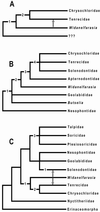Widanelfarasia, a diminutive placental from the late Eocene of Egypt
- PMID: 10694573
- PMCID: PMC15983
- DOI: 10.1073/pnas.040549797
Widanelfarasia, a diminutive placental from the late Eocene of Egypt
Abstract
The lower dentition of Widanelfarasia (new genus), a diminutive late Eocene placental from the Fayum Depression in Egypt, is described. Widanelfarasia exhibits a complex of features associated with incipient zalambdodonty and at least three unequivocal apomorphies [loss of P(1), an enlarged I(2) (relative to I(3)), and a basal cusp on I(2)], which provide weak support for its placement as a possible sister taxon of either a tenrecid-chrysochlorid clade or of solenodontids. The former hypothesis gains additional support from biogeographical evidence, but both scenarios are currently tenuous as Widanelfarasia is clearly not truly zalambdodont. Phylogenetic hypotheses positing affinities with tenrecids alone or chrysochlorids alone must invoke either convergent acquisition of zalambdodonty in these taxa or autapomorphic reversal in Widanelfarasia. Given these considerations, a relationship with more generalized taxa from the Laurasian Paleogene (e.g., geolabidids, nyctitheriids, leptictids) cannot yet be ruled out. Comparisons with other Paleogene Afro-Arabian forms are generally inconclusive. A relationship with the earlier Eocene Chambilestes from Tunisia-currently represented by a single specimen preserving P(4)-M(3)-seems possible based on the geometry and predicted occlusal relationships of these teeth, but cannot be confidently determined until these two taxa come to be represented by common diagnostic elements. Todralestes (late Paleocene, Morocco) exhibits general phenetic similarities to Widanelfarasia, but it is not yet known whether this taxon shares any of Widanelfarasia's unequivocal dental apomorphies. Pending the recovery of more informative material, we tentatively refer Widanelfarasia to Placentalia incertae sedis. Truly zalambdodont placentals remain conspicuously absent from the Paleogene of Afro-Arabia.
Figures


Similar articles
-
Hyainailourine and teratodontine cranial material from the late Eocene of Egypt and the application of parsimony and Bayesian methods to the phylogeny and biogeography of Hyaenodonta (Placentalia, Mammalia).PeerJ. 2016 Nov 10;4:e2639. doi: 10.7717/peerj.2639. eCollection 2016. PeerJ. 2016. PMID: 27867761 Free PMC article.
-
Craniodental and humeral morphology of a new species of Masrasector (Teratodontinae, Hyaenodonta, Placentalia) from the late Eocene of Egypt and locomotor diversity in hyaenodonts.PLoS One. 2017 Apr 19;12(4):e0173527. doi: 10.1371/journal.pone.0173527. eCollection 2017. PLoS One. 2017. PMID: 28422967 Free PMC article.
-
Earliest record of a parapithecid anthropoid from the Jebel Qatrani formation, Northern Egypt.Folia Primatol (Basel). 2001 Nov-Dec;72(6):316-31. doi: 10.1159/000052748. Folia Primatol (Basel). 2001. PMID: 11964500
-
A proper study for mankind: Analogies from the Papionin monkeys and their implications for human evolution.Am J Phys Anthropol. 2001;Suppl 33:177-204. doi: 10.1002/ajpa.10021. Am J Phys Anthropol. 2001. PMID: 11786995 Review.
-
Origin and evolution of gnathostome dentitions: a question of teeth and pharyngeal denticles in placoderms.Biol Rev Camb Philos Soc. 2005 May;80(2):303-45. doi: 10.1017/s1464793104006682. Biol Rev Camb Philos Soc. 2005. PMID: 15921053 Review.
Cited by
-
Protein sequence signatures support the African clade of mammals.Proc Natl Acad Sci U S A. 2001 Jan 2;98(1):188-93. doi: 10.1073/pnas.98.1.188. Proc Natl Acad Sci U S A. 2001. PMID: 11114173 Free PMC article.
-
New phiomorph rodents from the latest Eocene of Egypt, and the impact of Bayesian "clock"-based phylogenetic methods on estimates of basal hystricognath relationships and biochronology.PeerJ. 2016 Mar 1;4:e1717. doi: 10.7717/peerj.1717. eCollection 2016. PeerJ. 2016. PMID: 26966657 Free PMC article.
-
Resolving the relationships of Paleocene placental mammals.Biol Rev Camb Philos Soc. 2017 Feb;92(1):521-550. doi: 10.1111/brv.12242. Epub 2015 Dec 21. Biol Rev Camb Philos Soc. 2017. PMID: 28075073 Free PMC article.
-
Hyainailourine and teratodontine cranial material from the late Eocene of Egypt and the application of parsimony and Bayesian methods to the phylogeny and biogeography of Hyaenodonta (Placentalia, Mammalia).PeerJ. 2016 Nov 10;4:e2639. doi: 10.7717/peerj.2639. eCollection 2016. PeerJ. 2016. PMID: 27867761 Free PMC article.
-
Australia's first fossil marsupial mole (Notoryctemorphia) resolves controversies about their evolution and palaeoenvironmental origins.Proc Biol Sci. 2011 May 22;278(1711):1498-506. doi: 10.1098/rspb.2010.1943. Epub 2010 Nov 3. Proc Biol Sci. 2011. PMID: 21047857 Free PMC article.
References
-
- Sigogneau-Russell D. N Jb Geol Päleont Mon B. 1991;2:120–126.
-
- Sigogneau-Russell D. C R Acad Sci Paris II. 1991;313:1635–1640.
-
- Sigogneau-Russell D. C R Acad Sci Paris II. 1991;313:279–286.
-
- Sigogneau-Russell D. Acta Paleont Polonica. 1995;40:149–162.
-
- Gheerbrant E. C R Acad Sci Paris II. 1991;312:1249–1255.
Publication types
MeSH terms
LinkOut - more resources
Full Text Sources

